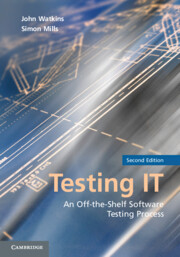Book contents
- Frontmatter
- Contents
- Foreword to the Second Edition by Geoff Thompson
- Foreword to the First Edition by Maurice Rosenburgh
- Acknowledgments
- 1 Introduction
- PART 1 THE TRADITIONAL TESTING PROCESS
- 2 An Overview of Testing
- 3 Testing Techniques
- 4 The Management and Planning of Testing
- 5 Unit Testing
- 6 Integration Testing
- 7 System Testing
- 8 Systems Integration Testing
- 9 User Acceptance Testing
- 10 Operations Acceptance Testing
- 11 Regression Testing
- 12 Improving the Testing Process
- 13 Introduction, Adoption, and Maintenance of the Testing Process
- 14 Agile Testing
- PART 2 THE TESTING PROCESS IN THE REAL WORLD: ILLUSTRATIVE CASE STUDIES
- PART 3 THE APPENDICES
- References
- Glossary
- Index
11 - Regression Testing
Published online by Cambridge University Press: 03 May 2011
- Frontmatter
- Contents
- Foreword to the Second Edition by Geoff Thompson
- Foreword to the First Edition by Maurice Rosenburgh
- Acknowledgments
- 1 Introduction
- PART 1 THE TRADITIONAL TESTING PROCESS
- 2 An Overview of Testing
- 3 Testing Techniques
- 4 The Management and Planning of Testing
- 5 Unit Testing
- 6 Integration Testing
- 7 System Testing
- 8 Systems Integration Testing
- 9 User Acceptance Testing
- 10 Operations Acceptance Testing
- 11 Regression Testing
- 12 Improving the Testing Process
- 13 Introduction, Adoption, and Maintenance of the Testing Process
- 14 Agile Testing
- PART 2 THE TESTING PROCESS IN THE REAL WORLD: ILLUSTRATIVE CASE STUDIES
- PART 3 THE APPENDICES
- References
- Glossary
- Index
Summary
“Quality comes for free as long as you pay for it”
Overview
The purpose of regression testing is to ensure that the application under test (AUT) still functions correctly following modification or extension of the system (e.g., user enhancements or upgrades). Typically, the new modifications or extensions will be tested to verify that they meet their requirements, after which a series of tests will be run to verify that the existing functionality still meets its requirements.
Regression testing is not strictly speaking a testing phase, but it is a testing technique that can be used with any of the testing phases described in the previous chapters. For example, if a test team were conducting a system test of a new release of the AUT, the test analyst would need to design a number of tests to verify the correctness of the new or modified functionality. In addition to the new tests, the test analyst would select (perhaps from the appropriate reuse pack – see Appendix I) a number of the tests from the previous system test(s) of the AUT in order to determine if any defects had been introduced into the AUT during the implementation of the new functionality.
- Type
- Chapter
- Information
- Testing ITAn Off-the-Shelf Software Testing Process, pp. 91 - 98Publisher: Cambridge University PressPrint publication year: 2010



